In years just ahead, the Air Force will maintain bare minimums of sufficiency in manpower, programs, and systems, and it will stay in that unhappy situation at least until the American economic situation improves.
As a result of this, the service can no longer tolerate programmatic delays. It will cancel nonperformers and will invest mainly in new systems it considers sure things—and relevant—throughout the near- to mid-term.
These were the tough messages delivered in February by top Air Force leaders at AFA’s Air Warfare Symposium in Orlando, Fla. Fresh from a two-day meeting of the service’s four-star generals, they described the Air Force as pulling its weight in the ongoing conflicts overseas but fighting a pitched battle against aged equipment, multiplying missions, and slack resources.
“It remains our No. 1 priority to prevail in today’s wars,” Air Force Secretary Michael B. Donley said in his keynote address. He ranked USAF’s top three contributions to the war effort as “projecting US power at great distances through air mobility,” closelyNun integrating air forces with ground units, and partnering with other air forces.
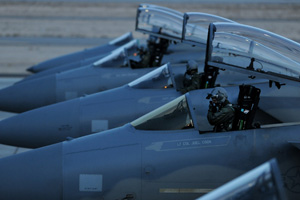 |
F-15 pilots go through preflight checks at Nellis AFB, Nev |
As a result, top USAF investment priorities, reflected in the Fiscal 2011 budget request just sent to Congress, are mobility, intelligence-surveillance-reconnaissance, command and control, and “building partner capacity.”
Donley said the Air Force “must be able to prioritize [its] requirements,” and those things considered not imminently necessary or affordable, or which USAF can rely on other entities to provide, will have to wait. It must “balance [its] capabilities with those of … joint and coalition partners, and balance risk in a fiscally constrained environment,” he said.
The active duty force will remain fixed at 332,000 people, with a further 71,000 in the Air Force Reserve and 107,000 in the Air National Guard. Any newly added missions have to be met within those limits, Donley said.
Moreover, “in the immediate future, I think our major programs are set,” Donley said, referring to an aviation investment plan sent to Congress along with the defense budget. “Beyond that, we will have to await an economic recovery [and] assess … the future of the economy” and “what level of resources will be provided to defense” in the next four to six years.
Chief of Staff Gen. Norton A. Schwartz, in a press conference during the symposium, said, “This is no longer a time for wishful thinking” about programs that might be created, or success in programs that are having trouble.
An Agile Fleet
Addressing himself to USAF’s suppliers, he said, “Tell me what you can do; I expect you to deliver what you promise.” The Air Force no longer has the dollars to spend on programs that don’t perform or don’t yield capabilities across many broad missions, because it doesn’t have enough funds to do all the things it should.
“There’s no question that our Air Force has been taking risk in infrastructure; our milcon [military construction] programs have been more anemic than we would prefer,” Donley told reporters. More importantly, though, “we have been struggling … with weapon system sustainment and with the readiness of nondeployed forces.”
Schwartz told reporters that maintenance checks and inspections are being deferred because equipment and people are needed on the front lines, and because of the “commitment to supporting the folks forward.” That means the forward based units get priority for funds.
However, “we cannot do this indefinitely,” Schwartz said. “We are getting to the point now where there’s very little management reserve on the readiness side [of] the Air Force.”
Air Combat Command chief Gen. William M. Fraser III said he’s starting to see “a slight decline” in mission capable rates, but doesn’t think it has reached an “alarming” level yet. “We are still putting resources to … trying to turn those slight trends around,” Fraser said.
In his address, Fraser said he’s determined that USAF will not return to the patterns of the late 1970s, when the service “created a hollow force with a large but unsustainable inventory that could not deliver.” The Air Force has very deliberately chosen instead to operate “a smaller, more capable fleet that is agile and poised to take on any challenge that we may see.” This was the thought underlying ACC’s proposed early retirement of some 250 fighters, or more than three wings’ worth of capability.
“Given the operations we face today, a large hollow force would undermine our nation’s strategic goals, and we cannot allow that to happen,” Fraser said.
Donley noted that the financial savings of not operating the aircraft are to be put toward boosting the combat power of those that remain—some 2,050 fighters.
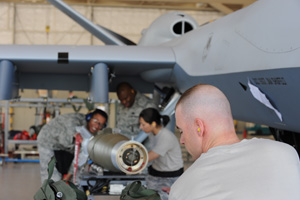 |
SrA. Jason Atwell (r) operates a bomb lift while other airmen ready a bomb for a Reaper. |
He noted that of the 4,100 manpower slots saved by the retirements, 3,600 have already been shifted to “support operations, processing, exploitation, and dissemination of collected intelligence. We’re doubling the number of ISR liaison officers assigned to deployed ground forces.”
Because funds are so tight, Donley urged Congress not to direct heavy changes in the Air Force budget, asking for the freedom to manage the force within the funds available, setting priorities and taking risks where the service believes it can live with them.
He specifically asked that Congress not add any further C-17s to the fleet. A soon-to-be-released mobility study, he said, will show that the Air Force still only needs about 300 strategic airlifters. However, with the number of C-17s already delivered or in the pipeline, combined with C-5s that are receiving significant upgrades, USAF will have more than 330 strategic airlifters.
“We need to be allowed to manage the force to what we think our requirement is and not maintain capacity in excess of the requirement,” he told reporters.
The extra aircraft represent “a two-way hit,” he added, saying that not only does Congress subtract money from higher USAF priorities to buy the aircraft, but it then forces the service to make other cuts to come up with funds to operate them.
“We have enough in this area, and we need to put the marginal dollars toward other requirements,” Donley said. To maintain the fleet it has with funds available, USAF is asking Congress for permission to retire some of the oldest C-5As.
Moreover, the Air Force is rethinking the way it does business to create the effect of more aircraft without buying them. Air Force Materiel Command chief Gen. Donald J. Hoffman said AFMC has been asked to help Air Mobility Command get more aircraft into action to support the current surge in Afghanistan. Toward that end, he said, less-critical inspections and repairs are being deferred and some aircraft aren’t being inducted into depot to get AMC “through this surge period here, through the summer.”
Hoffman said AFMC has pilot programs under way to study how it can break down depot maintenance such that aircraft will come in for shorter stays and be out of service for less time. Typically, Hoffman said, some aircraft sit idle at depots because a problem has been found with them that requires a part, an engineering analysis, or an item not at hand. They remain grounded until the needed item is produced.
Anticipation
In the future, he sees the aircraft moving around more while in depot, going to where the parts or capability exist to fix them, or returning to service with write-ups that require eventual repair but don’t affect safety of flight. When the part or engineering fix is ready, they will go back to depot. More work will be done at bases to assess the health of aircraft before they go to depot, so parts and engineering will be ready when they arrive, leading to shorter visits and less downtime.
The top modernization priority for the Air Force is the KC-X tanker, followed closely by the F-35, Donley asserted. The fact that these programs are “extending over 10 or 20 or 25 years” is evidence of the fact that “the assets are not cheap, and we don’t have all the investment dollars we would like to do that on a more rapid schedule.”
The Air Force hopes to award a contract for the tanker this summer. The F-35, though, will be delayed in order to reduce the concurrency of testing and production.
Schwartz forecast that the F-35 could incur a Nunn-McCurdy breach, which indicates cost and schedule have gotten way out of line. The Pentagon indeed declared such a breach in March, and said it had taken dramatic steps to restructure the program. Such an event requires a program to be restructured to live within its base budget, but service leaders didn’t know yet how this might happen.
Fraser said that his command is re-examining the requirements necessary to declare initial operating capability on the F-35, scheduled for 2013. However, he will not declare IOC simply to meet “a date.” His concern is to have a capability, and he said he will wait until it’s ready.
“I’m confident in the restructure that we’ve recently gone through,” Fraser said. “I’m confident in the changes that have been made and with the program that is laid in right now. Now it needs to produce.”
Donley was asked if the appearance of the Russian PAK FA fifth generation fighter had caused the Air Force to rethink its plans for the F-22, terminated last fall at 187 aircraft, or the pace of the F-35, or the early retirement of more than three wings of fighters.
“No,” Donley said simply.
“We expect aerospace technology to be advancing in all of the developed countries,” and Russia is no exception, he said.
“We’re already anticipating advanced fighters, advanced air defenses, advanced weapons of all different types to be part of our future that we have to take account for, and we have been doing that.”
The aviation investment plan submitted to Congress with the Fiscal 2011 defense budget called for no new airlifters, bombers, or other large aircraft—besides tankers—for at least a decade. Does Donley have concerns about whether the US industrial base can survive a long drought of new programs
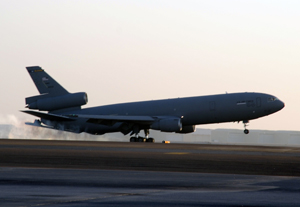 |
A KC-10 touches down at a base in Southwest Asia. |
The $1.5 billion to be invested in advanced stealth, communications, and other enablers—all for the next long-range strike system—has “addressed the issue of industrial base engineering talent at the sort of high-end, very sophisticated” technologies, Donley said. While he acknowledged that the long hiatus in new programs may cause the industrial base to dwindle to just one supplier in many key product areas, he observed, “I think we’ve already been doing that.” However, he said the Pentagon’s acquisition, technology, and logistics shop is taking a fresh look at industrial base issues.
Both ACC and the newly minted Global Strike Command will have claim on the new bomber, but the latter’s commander, Lt. Gen. Frank G. Klotz, said his organization will be a forceful advocate for long-range strike capabilities. He told symposium attendees that long-range strike is a fundamental capability the nation expects of its Air Force, and that capability will be fulfilled both by retaining today’s bombers for decades to come and with the new system.
Klotz asserted that GSC is “absolutely committed to providing robust and relentless advocacy” for the bomber mission, both conventional and nuclear. He also said that, as long as nuclear weapons are part of the nation’s deterrent force, bombers will be part of that deterrent. However, he acknowledged that the B-52 and even B-2A are “aging aircraft” and will pose “significant challenges” to keep modernized and fully capable for their missions.
Hoffman said AFMC, as the logistics side of USAF’s nuclear force, has made “a seamless transition” in taking over those functions. In separate incidents that came to light in 2007 and 2008, the Air Force was criticized for having lax control over its nuclear parts, but Hoffman said that today every nuclear element—some 400 items, “from control panels in aircraft to relays and switches”—has “a wrapper” around it and is being tracked. When these parts are moved, “there’s a very definite process” involved.
“How it gets moved and how it gets received and tracked is now quite different than what it was two years ago,” when the system was flagged for problems.
Hoffman said no one is assuming the nuclear inventory issue has been put to rest.
“I’ll always put nuclear No. 1 until somebody tells me to do something different,” he said. However, while he called USAF’s nuclear weapons of today safe, secure, and reliable, “I cannot project that confidence forward into the future … unless we do some modernization.” The weapons are being sustained for now, but “the pain of that sustainment continues to grow as these things age.”
While most speakers were talking about doing with less, Hoffman was able to report that he is bringing in more people. To comply with Air Force, Pentagon, and Congressional directives to enhance the in-house expertise of the acquisition system, Hoffman said he is bringing on new civilian hires “at a rate that no one can remember we’ve ever done before.”
He has gone beyond simply “fill[ing] the empty seats” and is growing AFMC’s civilian acquisition workforce “back up to a level where it can properly run programs.”
Beyond filling 2,000 vacancies, Hoffman said he has marching orders to bring on “thousands and thousands” of former contractors as USAF employees. He’s trying to beat the clock, though: It’s been common knowledge for years that most of AFMC’s workforce is either retirement-eligible or will be soon. The weak economy has blunted an expected exodus, but Hoffman doesn’t want to be caught short by a sudden uptick in retirements, should a more prosperous wind blow.
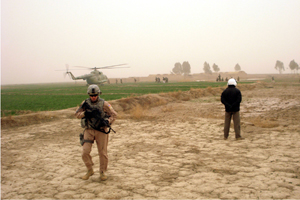 |
USAF and Afghan National Army Air Corps members provide security during a humanitarian mission in Kandahar, Afghanistan. |
Training Is Key
He has also abandoned an effort, started a few years back, to organize AFMC by wings, groups, and squadrons. Most of its organizations were too small to make that concept work—leading to, in one case, a one-man squadron—and most of its workforce was civilian. The command has returned to organizing by directorates, Hoffman noted.
The Air Force has given up many training events in order to supply people and machines for the war effort. That can’t go on forever, Fraser said.
“We need to make sure we are staying up on the exercises,” he said. “Not only the Red Flags [and] Green Flags, but even the local exercises.” The training of airmen “is our asymmetric advantage” and gives him confidence that USAF can defeat, for example, the PAK FA.
Fraser said studies are under way to see how much more training can be accomplished with simulators and distributed mission operations, where airmen can participate in a wargame virtually, from a long distance away.
He would like to see exercises recognized more for their contribution to “building partnership capacity,” saying that this is exactly what is happening every time USAF forces train with their counterparts in other countries.
Hand in hand with ACC, Air Education and Training Command is conducting a sweeping review of all its training activities, the better to dovetail them with real-world operations, AETC chief Gen. Stephen R. Lorenz reported. The objective is to make airmen better prepared for whatever they will face in the field. Many schools, such as basic training, have had their courses extended in the last few years, with good result.
Lorenz said his command has added “innovate” to its basic mission of “recruit, train, and educate,” because with new missions emerging on practically a monthly basis, AETC has had to step in again and again to train people for new activities. He noted that the command is in the midst of an experiment to take officers who have not had standard USAF pilot training and teach them to fly remotely piloted aircraft (RPA). The experiment is having some successes, but the course is being adjusted constantly to find the right duration and level of experience for the RPA pilots.
The quality of USAF recruits has never been better, Lorenz said, but the pool of eligible young people on which to draw is dwindling and USAF must work harder to attract and retain new airmen.
Replacing the T-38 trainer will be AETC’s next big acquisition challenge, Lorenz said. The existing fleet is 43 years old and, although new wings and other upgrades have extended the aircraft’s life, he said a new aircraft must be online by 2026.
In fact, AETC is trying to move up its acquisition “a couple of years,” Lorenz said, because teardown analyses have identified “156 single points of failure” on the T-38, and that is too many to risk for more than another 15 years, he said. Likewise, the T-1 Jayhawk will need to be replaced in about the same timeframe, but these acquisitions might be more manageable with a change in the way specialized undergraduate pilot training is conducted.
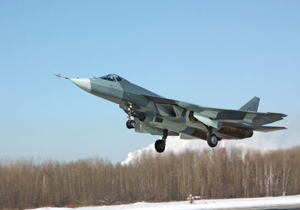 |
The Russian PAK FA takes to the air. USAF officials are confident that American airmen can defeat the fifth generation fighter. |
Lorenz also said AETC will overhaul the way it recruits and trains battlefield airmen. The current pipeline washes out 86 percent of inductees, he said, and he wonders if it is designed to weed people out or train people for the job.
However, a slightly different note was sounded by CMSAF James A. Roy. Asked in a presentation what worries him, Roy said he would rather have airmen overtrained for the things they might encounter when deployed, rather than risk that they be thrust into a situation for which they are unprepared. He is seeking more training opportunities for airmen with the Army, especially in those locations and in those tasks where airmen will be side by side with their Army brethren in possible combat situations.
Contested Space
More broadly, USAF must “continue to manage” the airmen in its most stressed career fields—mostly battlefield airmen—to make sure they are getting as much relief in their operating tempos as possible, Roy said. There is real danger of burning out airmen who have experienced unremitting one-to-one dwell deployments, or longer.
Battlefield airmen will continue to play a fundamental role in combat operations for the foreseeable future, Schwartz said, as irregular warfare continues to be one of the Air Force’s main activities.
Fraser said that IW “is not just a part of today’s fight. I contend that it’s going to be an enduring mission, and therefore it’s an ACC priority.”
Toward that end, USAF is seeking to convert new C-130J aircraft into AC-130 gunships, to replace AC-130H-based aircraft that are more than 30 years old. Schwartz said the aircraft will not only have infrared and electro-optical sensors and “a gun of some kind,” but “other kinds of guided munitions capabilities … that were certainly not available when the H models were originally fielded, or even 20 years later.”
The Air Force will probably seek just 112 new combat search and rescue helicopters to fulfill the capabilities that were to have been supplied by the terminated CSAR-X program which aimed to buy 141 machines. That won’t fix the one-to-one dwell time currently afflicting CSAR practitioners, but, again, funding is limited.
“This is all about choices,” Schwartz told reporters. “I’m not presupposing the outcome, but I don’t want to raise expectations, either.”
In his speech, Schwartz focused on space, and said that the days of the US enjoying a monopoly on space—access to it, unfettered use of space systems for ISR and communications—are over.
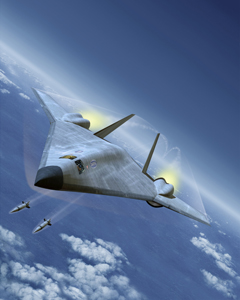 |
An artist’s conception of the next generation bomber. Both ACC and Global Strike Command will have claim on the new bomber.
|
“Current realities continue to suggest the inevitability of contested space,” and USAF must prepare for that, he said.
To assure that the Air Force has access to its networks and to the ISR data upon which commanders have come to rely, he said his “foot stomper” was that USAF must invest in other ISR systems—principally RPAs—to make an attack on its space systems less profitable for an enemy. Space-based ISR systems “should at least be, in part, backed up by other systems,” he said.
“They may not be identical” in the products they provide, “but we need to think in a cross-domain way when seeking such resilience.” Further, space systems can be defended by making them so distributed—in the form of much smaller, less costly satellites—that an attempt to take down the system would be fruitless, Schwartz said. Investing in such “smaller, simpler” satellites versus larger, powerful ones will “be the very best approach” in some cases.
“With flattening budgets and what no doubt will be declining purchasing power, these sorts of trade-offs, while difficult, must be considered,” he said.